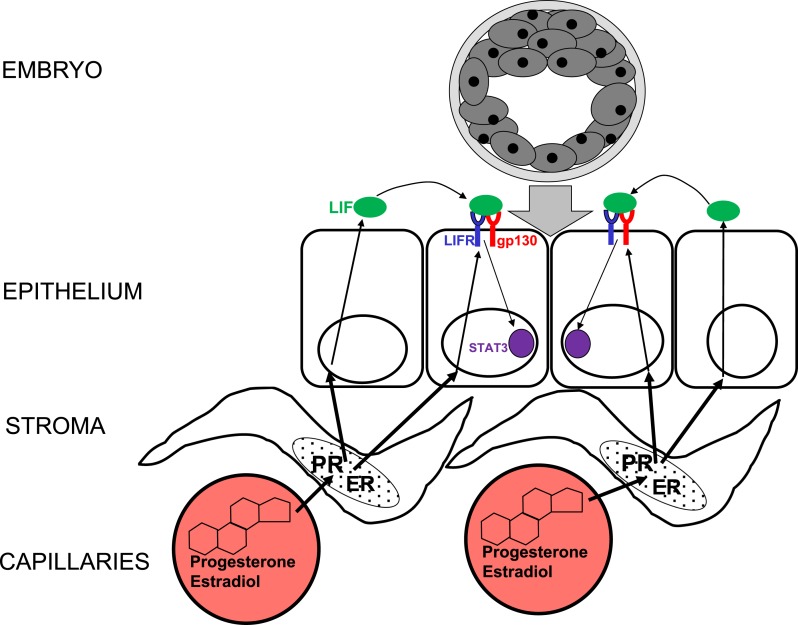Cytokine production and action in the endometrium play indispensable roles during the extremely complex process of embryo implantation and development (1). In particular, implantation requires the intimate involvement of the gp130 cytokines that show functional redundancy and pleiotropy and act via multimeric receptors sharing a common subunit named gp130. The best characterized gp130 cytokine that facilitates implantation is leukemia inhibitory factor (LIF). LIF signals through the heterodimeric receptor complex LIF receptor (LIFR)/gp130 that activates nuclear translocation of signal transducer and activator of transcription 3 (STAT3) (1). The LIF-LIFR-gp130-STAT3 pathway is essential for implantation in mice and seems to play key roles in women (2). During the window of implantation, LIF is produced primarily by the deeply invaginated (glandular) portion of the human endometrial epithelium, whereas LIFR is primarily expressed in luminal endometrial epithelial cells that come in initial contact with the embryo (3). This is suggestive of a key paracrine mechanism between LIF and its receptor during the implantation window in women. In this issue of Endocrinology, Cheng et al. (4) elegantly demonstrate the essential role of mouse LIFR in implantation; this concludes a series of publications from this group showing that the LIF-LIFR system seems to be essential for uterine receptivity but not for embryo competency (2, 4, 5).
Estrogen and progesterone are the crucial endocrine factors for the preparation of the endometrium for implantation because sequential administration of exogenous estrogen followed by the addition of progesterone in a postmenopausal woman is sufficient for the successful implantation of a donor embryo (6). It then follows that the local hormonal mechanisms in endometrial tissue including cytokine and growth factor production and action such as LIF-LIFR-gp130-STAT3 signaling in epithelial cells are under the ultimate control of estrogen and progesterone (Fig. 1). In fact, the highest levels of LIF, LIFR, and gp130 expression in human endometrial epithelial cells coincide with peak progesterone levels (2, 3). Progesterone arrives in endometrial tissue via blood vessels that first come into contact with stromal cells containing progesterone receptor (PR), which is induced by estrogen and its receptor (Fig. 1) (6). It is, therefore, tempting to consider that ligand-activated PR in endometrial stromal cells is instrumental for sending paracrine signals to adjacent glandular and luminal epithelium to induce LIF and LIFR expression (Fig. 1).
Figure 1.
Paracrine interactions between endometrial stromal and epithelial cells, which mediate the actions of estradiol and progesterone via their receptors ER and PR, and LIF via its receptors LIFR and gp130 during the process of embryo implantation. ER, estrogen receptor; PR, progesterone receptor.
This landmark publication by Cheng et al. (4) uncovers key mechanisms related to the roles of LIFR and its downstream signaling pathways in preparing the endometrium for implantation and also raises many important questions : (1) What are the specific and redundant functions of gp130 cytokines in implantation? (2) What aspects of the murine data are applicable to women? (3) What are the genome-wide mechanisms that mediate the broad biologic effects of STAT3 in endometrial epithelial cells? (4) Do signaling pathways other than Janus kinase 1-STAT3 mediate LIF action for implantation? (5) How do progesterone and stromal or epithelial PR regulate expression of epithelial LIF, other gp130 cytokines, and their receptors? (6) Can the LIF pathway be targeted to enhance fertility or for contraception? It is likely that answering some of these questions will open new avenues of research and critical clinical applications.
Acknowledgments
Acknowledgments
This work was supported in part by National Institutes of Health Grant R37-HD38691.
Disclosure Summary: The author has nothing to disclose.
Footnotes
- LIF
- leukemia inhibitory factor
- LIFR
- leukemia inhibitory factor receptor
- PR
- progesterone receptor
- STAT3
- signal transducer and activator of transcription 3.
References
- 1.Dimitriadis E, White CA, Jones RL, Salamonsen LA. Cytokines, chemokines and growth factors in endometrium related to implantation. Hum Reprod Update. 2005;11(6):613–630. [DOI] [PubMed] [Google Scholar]
- 2.Cullinan EB, Abbondanzo SJ, Anderson PS, Pollard JW, Lessey BA, Stewart CL. Leukemia inhibitory factor (LIF) and LIF receptor expression in human endometrium suggests a potential autocrine/paracrine function in regulating embryo implantation. Proc Natl Acad Sci USA. 1996;93(7):3115–3120. [DOI] [PMC free article] [PubMed] [Google Scholar]
- 3.Aghajanova L, Stavreus-Evers A, Nikas Y, Hovatta O, Landgren BM. Coexpression of pinopodes and leukemia inhibitory factor, as well as its receptor, in human endometrium. Fertil Steril. 2003;79(Suppl 1):808–814. [DOI] [PubMed] [Google Scholar]
- 4.Cheng J, Rosario G, Cohen TV, Hu J, Stewart CL. Tissue specific ablation of the LIF receptor in the murine uterine epithelium results in implantation failure. Endocrinology. 2017;158(6):1916–1928. [DOI] [PMC free article] [PubMed] [Google Scholar]
- 5.Stewart CL, Kaspar P, Brunet LJ, Bhatt H, Gadi I, Köntgen F, Abbondanzo SJ. Blastocyst implantation depends on maternal expression of leukaemia inhibitory factor. Nature. 1992;359(6390):76–79. [DOI] [PubMed] [Google Scholar]
- 6.Bulun S, Adashi E. The physiology and pathology of the female reproductive axis. Chapter 16. In: Larsen PR, Kronenberg HM, Shlomo M, Polonsky KS, eds. Williams Textbook of Endocrinology. 10th ed. Philadelphia, PA: Saunders Co; 2003:749–811. [Google Scholar]



